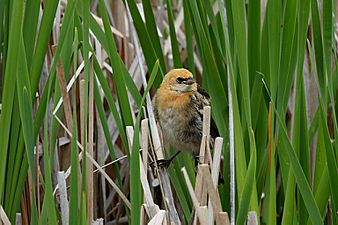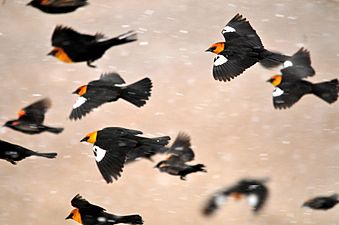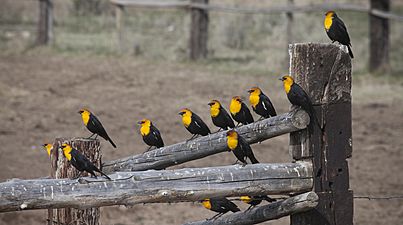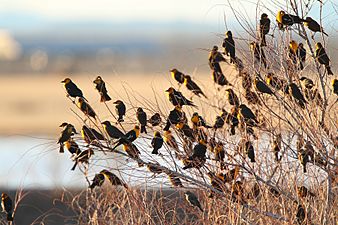Yellow-headed blackbird facts for kids
Quick facts for kids Yellow-headed blackbird |
|
|---|---|
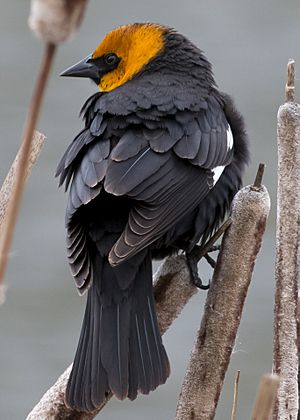 |
|
| Male in British Columbia, Canada | |
| Conservation status | |
| Scientific classification | |
| Genus: |
Xanthocephalus
|
| Species: |
xanthocephalus
|
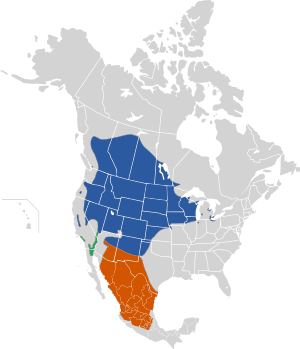 |
|
| Range of X. xanthocephalus Breeding range Wintering range Year-round range | |
The yellow-headed blackbird (Xanthocephalus xanthocephalus) is a cool bird that's part of the blackbird family. It's the only type of bird in its special group, called Xanthocephalus. These medium-sized blackbirds are known for their bright colors and interesting habits.
Contents
Yellow-headed Blackbird Facts
What Do They Look Like?
Yellow-headed blackbirds are easy to spot! They have a pointed beak.
Here are some quick facts about their size:
- Length: They are about 8.3 to 10.2 inches (21 to 26 cm) long.
- Weight: They weigh between 1.6 and 3.5 ounces (44 to 100 grams).
- Wingspan: Their wings can spread 16.5 to 17.3 inches (42 to 44 cm) wide.
The adult male yellow-headed blackbird is mostly black. But its head and chest are a bright yellow! They also have a white patch on their wings. You might only see this white patch when they are flying.
Adult female yellow-headed blackbirds are mostly brown. Their throat and chest are a duller yellow. Both male and female yellow-headed blackbirds look a bit like the yellow-hooded blackbirds found in South America.
Where Do They Live?
Yellow-headed blackbirds love to live in marshes. These are wet, grassy areas with lots of cattail plants. They build their nests right in the marsh plants. You can find them mainly in North America, especially west of the Great Lakes.
These birds often nest in big groups called colonies. They sometimes share their marsh homes with red-winged blackbirds.
How Do They Behave?
During the time they are raising their young, male yellow-headed blackbirds are very protective. They spend a lot of time sitting on tall reeds. They will show off or chase away any other birds that come too close to their nests. They are very careful about things that might harm their nests, like marsh wrens. They change how they act to keep their babies safe.
Where Do They Go in Winter?
When winter comes, these blackbirds fly south. This journey is called migration. They travel to the southwestern United States and Mexico. They often fly in huge groups with other kinds of birds.
Only a few places in the United States have yellow-headed blackbirds all year. These are the San Joaquin Valley and the Lower Colorado River Valley in Arizona and California.
What Do They Eat?
Yellow-headed blackbirds find their food in the marsh, in fields, or on the ground. Sometimes, they even catch insects while flying! Their main diet includes seeds and insects. When it's not nesting season, they often eat in big flocks with other bird species.
What Do They Sound Like?
This bird has a very unique song. Some people say it sounds like a rusty gate hinge creaking open!
Gallery
See also
 In Spanish: Tordo cabeciamarillo para niños
In Spanish: Tordo cabeciamarillo para niños




